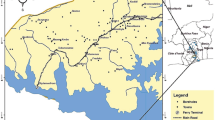Abstract
A point count index method using a well driller’s log and field measurements has been developed following the DRASTIC and SINTACS procedures to map and evaluate the vulnerability of a coastal plain aquifer to surface and near surface contamination. The input parameters with the acronym CALOD include clay layer thickness (C), aquifer media character (A), lateritic layer thickness (L), overlying layer character (O) and the depth to groundwater level (D). The CALOD vulnerability potential index (CALOD index) is computed as the sum of the products of weights and ratings assigned to each of the input parameters. The CALOD index, varying between 15 and 75, is divided into four classes: high (>60), high-medium, (40–60), low-medium (20–40) and low (<20). The CALOD index is then used to produce a vulnerability potential map for the area. From the map, areas of high, high-medium and medium-low are consistent with the upper gravelly aquiferous zone while areas of medium-low and low are restricted to the deeper lower sandy aquiferous layer. The most important parameters affecting groundwater vulnerability to pollution in coastal areas include saturated thickness of the aquifer, depth to groundwater level, lateritic layer thickness and the aquifer media character. The concentration of some chemical pollution indicators (electrical conductivity, K, NO3, Cl and metal load) are relatively higher for the highly vulnerable shallower upper gravelly unit in comparison to the less vulnerable deeper sandy unit. This method is very suitable for coastal plain sand aquifers especially, where data is scare.







Similar content being viewed by others
References
Aller L, Bennet T, Lehr JH, Petty RJ, Hackett G (1987) DRASTIC: a standardised system for evaluating groundwater pollution potentials using hydrogeological settings. EPA/600/2–87/035, US Environmental Protection Agency, Washington, DC, 455 pp
Al-Zabiet T (2002) Evaluation of aquifer vulnerability to contamination potential using the DRASTIC method. Environ Geol 43:203–208
Bekesi G, McConchie JA (2002) The use of aquifer media characteristics to model vulnerability to contamination, Manawatu region, New Zealand. Hydrogeol J 10:322–331
Civita M (1994) Vulnerability maps of aquifers subjected to pollution: theory and practice (In Italian). Pitagora Editrice, Bologna
Civita M, De Regibus C (1995) Sperimentazione di alcune metodologie per la valutazione della vulnerabilita degli aquiferi. Q Geol Appl Pitagora, Bologna, 3:63–71
Edet AE, Okereke CS (2002) Delineation of shallow groundwater aquifers in the coastal plain sands of Calabar area (southern Nigeria) using surface resistivity and hydrogeological data. J Afr Earth Sci 35:433–443
Foster SSD (1987) Fundamental concepts in aquifer vulnerability, pollution risk and protection strategy. In: Duijvenbooden W van, Waegeningh HG van (eds) TNO Committee on Hydrological Research, The Hague. Vulnerability of soil and groundwater to pollutants, Proceedings and Information 38:69–86
Acknowledgements
The authors are grateful to the different water development agencies and private water drilling companies for assistance during data acquisition. The Alexander von Humboldt (AvH) Foundation and the German Academic Exchange Service (DAAD) are acknowledged for providing fellowship and field equipment to the first author.
Author information
Authors and Affiliations
Corresponding author
Rights and permissions
About this article
Cite this article
Edet, A.E. Vulnerability evaluation of a coastal plain sand aquifer with a case example from Calabar, southeastern Nigeria. Env Geol 45, 1062–1070 (2004). https://doi.org/10.1007/s00254-004-0964-9
Received:
Accepted:
Published:
Issue Date:
DOI: https://doi.org/10.1007/s00254-004-0964-9




